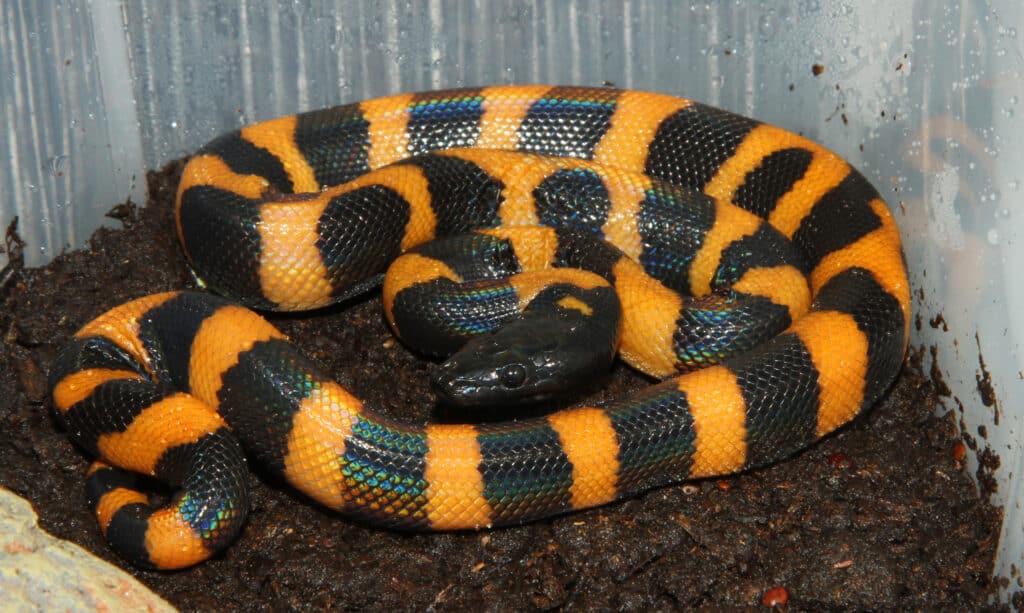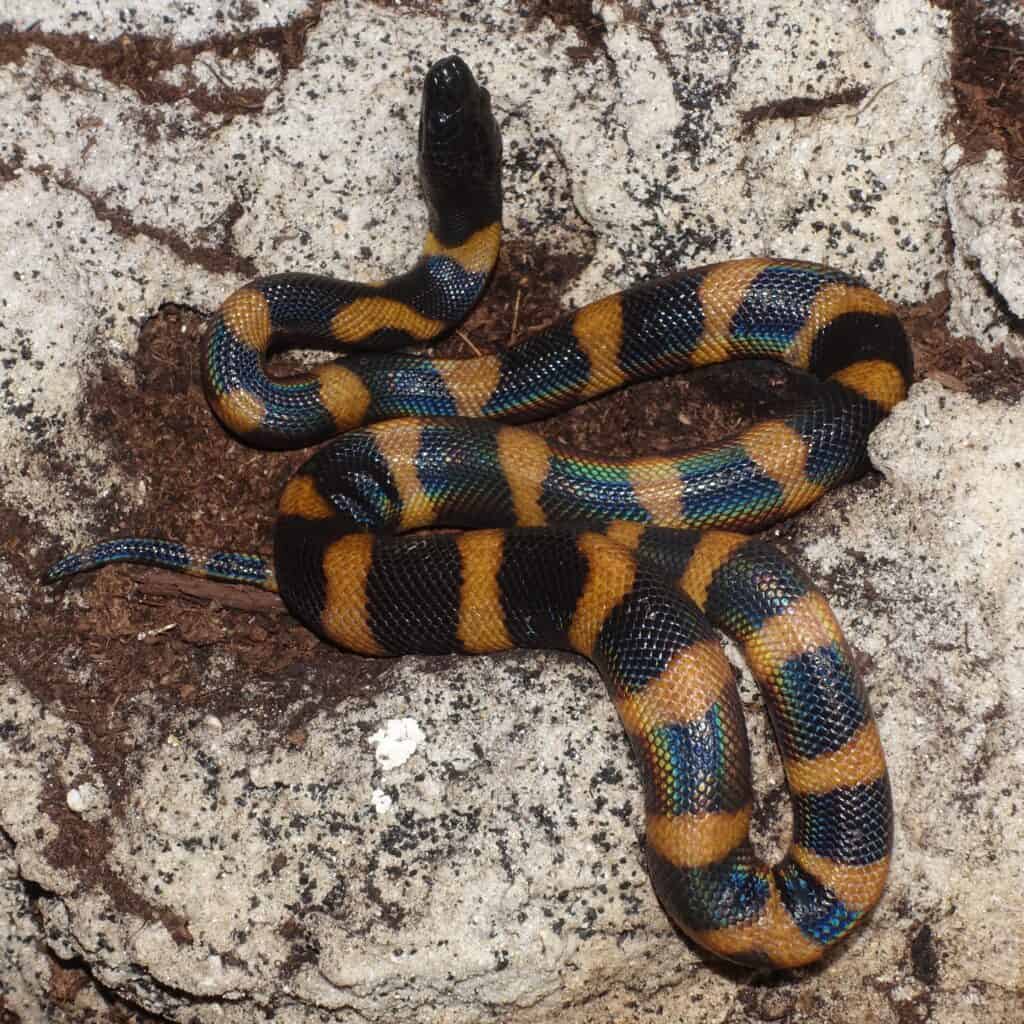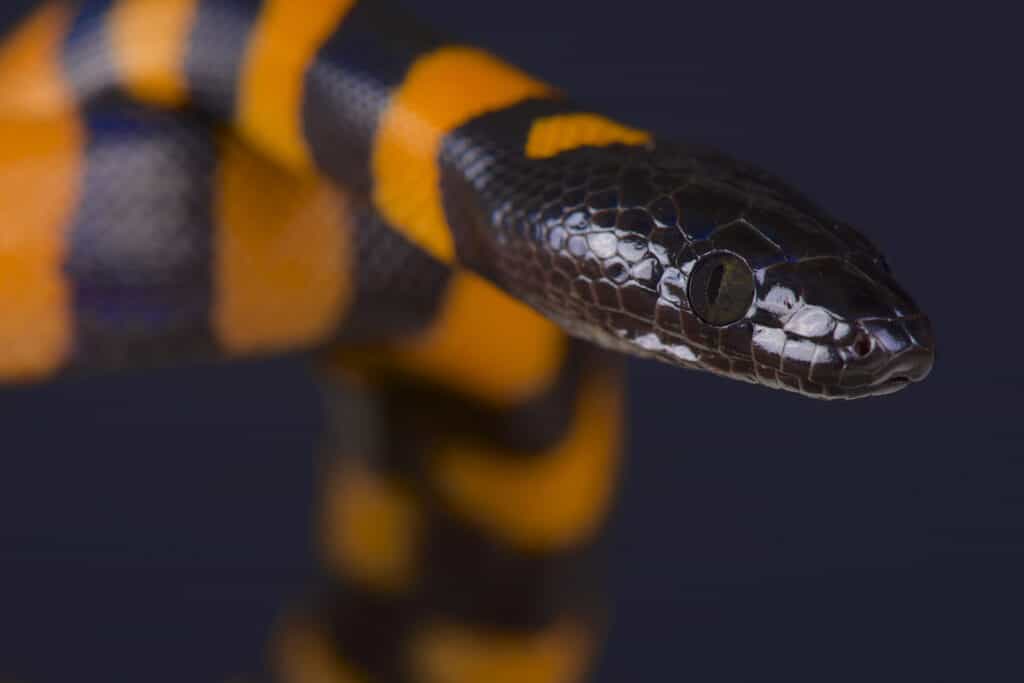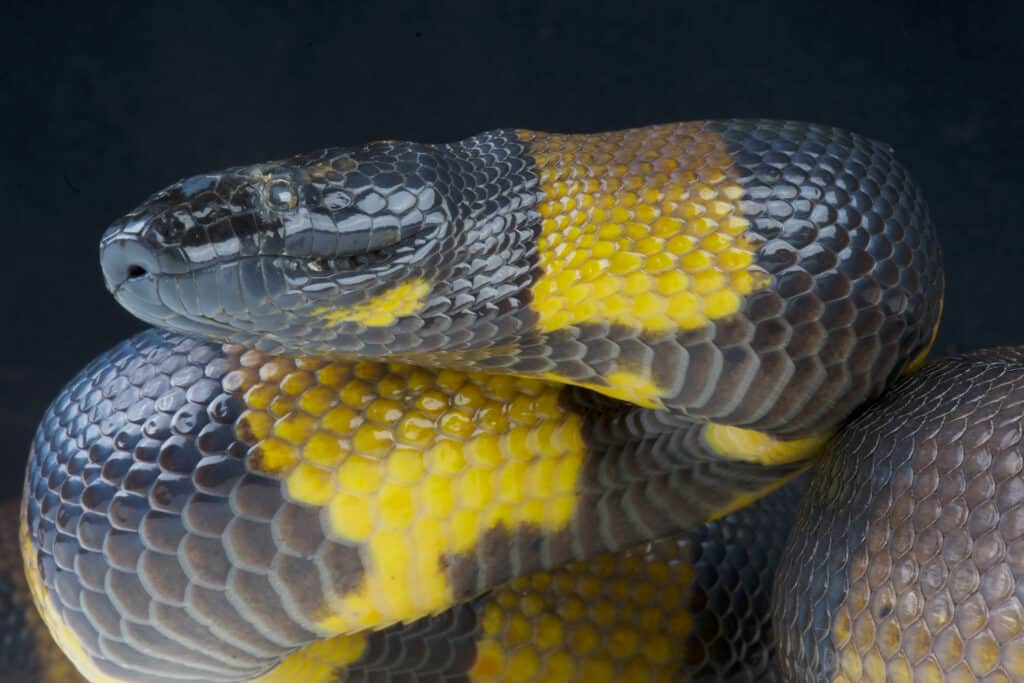Bismarck Ringed Python
Bothrochilus boa
When these snakes are babies, they look like Halloween snakes with their bright orange and black bands.
Advertisement
Bismarck Ringed Python Scientific Classification
- Kingdom
- Animalia
- Phylum
- Chordata
- Class
- Reptilia
- Order
- Squamata
- Family
- Pythonidae
- Genus
- Bothrochilus
- Scientific Name
- Bothrochilus boa
Read our Complete Guide to Classification of Animals.
Bismarck Ringed Python Conservation Status

Bismarck Ringed Python Facts
- Prey
- Small mammals, lizards, possibly other snakes
- Main Prey
- Rodents
- Name Of Young
- Hatchling, snakelet
- Group Behavior
- Solitary
- Solitary except during mating season
- Fun Fact
- When these snakes are babies, they look like Halloween snakes with their bright orange and black bands.
- Estimated Population Size
- Unknown
- Biggest Threat
- Over collection for the pet trade.
- Most Distinctive Feature
- Black and orange to orange-brown rings
- Other Name(s)
- Ringed python
- Age Of Independence
- When they hatch
- Diet for this Fish
- Omnivore
- Lifestyle
- Nocturnal
- Crepuscular
- Favorite Food
- Small mammals
- Common Name
- Ringed python
- Special Features
- Glossy black head
- Number Of Species
- 1
- Location
- Bismarck Archipelago
- Average Clutch Size
- 9
View all of the Bismarck Ringed Python images!
The Bismarck ringed python is a medium-sized, nonvenomous snake that lives in the underbrush and leaf litter of its island home.
Its vibrant juvenile color, beautiful adult color with iridescent scales, and active personality make this an interesting snake. This little-known snake is one of the most beautiful python species in the world.
Incredible Bismarck Ringed Python Facts
- These snakes are bright orange and black when they hatch. Then, over their first year or two of life, change to orange-brown or yellow and black.
- They only have heat-sensing pits on their lower rear lip, fewer than most python species.
- The female may incubate the eggs, or she may not. They don’t seem as careful with their eggs as other pythons.

Scientific Name and Classification
A monotypic species, Bothrochilus boa is uniquely beautiful. It’s the only species in the Bothochilus genus, and its specific name is interesting, as boa typically generically refers to large snakes. It’s where scientists got the genus name for the Boa constrictor. However, Bothrochilus is a little harder to track down. It’s a compound word combining Bothros which refers to a pit or hole, and chilus, which means -like.
Its common name is much easier to figure out because the Bismarck ringed python lives on several islands in the Bismarck Archipelago and is a python with ringed markings.
Appearance
Bismarck ringed pythons are medium-sized snakes; adults grow to about 5-6 feet long. These beautiful snakes have a fantastic color pattern as juveniles that consists of bright orange with black rings, stripes, or blotches. Then, after about a year, they begin an ontogenic change, which is where the change occurs because of their age. When these pythons begin their change, their orange fades to brown. Usually, a light spot behind the eye remains; however, by the time they’re 12-24 months old, they have taken on their adult colors and are orange-brown and black with highly iridescent scales. There’s variation between adults in the depth of the orange-brown, and some are almost black. The black bands can also vary widely, from being very regular bands to being highly irregular and sometimes absent.
Their heads are small and glossy black, with dark eyes. Ringed pythons have four heat-sensitive pits on the back of their lower jaw but none on the upper. Like other pythons, they have dozens of sharp teeth, but they aren’t very aggressive. Unlike other pythons, this species has a narrow, pointed snout, which may help it burrow. Their bodies are somewhat thick for their length, but they’re not as stocky as other terrestrial pythons.

When Bismarck Ringed Pythons are about a year old, they begin an ontogenic change. At this time, their orange stripes fade to brown. Between the ages of 1 and 2 years old, they will have adopted their adult colors: orange-brown and black with highly iridescent scales.
©Michal Sloviak/Shutterstock.com
Behavior
These snakes’ semi-fossorial lifestyle makes any true population count difficult, and researchers know little about their lifestyle in the wild. Most of what we know about their behavior comes from people who keep them as pets.
Bismarck ringed pythons are nocturnal and crepuscular, but they’re active snakes and will show themselves at any point during the day. They forage actively, so while they likely try to sneak up on their prey, they’re not going to wait for their food to come to them. Keepers say that their behavior is more like that of a colubrid; they’re not at all lethargic and slow-moving like other pythons.
This species isn’t aggressive, but handling them is more of an activity than a neck decoration. They don’t really stop moving and have high metabolisms that require more frequent feedings.

Bismarck ringed pythons are nocturnal and crepuscular.
©Michal Sloviak/Shutterstock.com
History and Evolution
Just like other snake species of snakes, the python’s predecessors were also reptiles but with legs. These animals were more aquatic-based. Snakes either lost their legs or became vestigial, as they became more and more unused. It is interesting to imagine animals evolving to have legs and then evolving to lose them! As these snakes adapted to living as low to the ground as they can to avoid enemies and be closer to their prey.
Pythons were previously classified with boas, but modern research has shown that the pythons and boas are separate species due to convergent evolution in different parts of the world, much like monkeys evolved differently in Africa and South America while having shared ancestors. Some of the major differences are that boas give birth to live young, and pythons lay eggs. Pythons also have their heat-sensing pits on their labial scales, and boas have them in between their labial scales.
In particular, the Bismarck Ringed Python probably took advantage of its own great swimming prowess, much like other pythons, to swim out into ocean waters in search of food and suitable habitats. Finding a home in the Bismarck Archipelago must have provided an ecosystem that allowed this snake to thrive and evolve into its current unique form!
Habitat and Diet
Bismarck ringed pythons are endemic to the Bismarck Archipelago north of New Guinea. They are primarily found in the leaf litter and vegetation of the rainforest but can also be found in coconut plantations. People often find these snakes hiding in piles of coconut husks where they use their small heads to help burrow into the ground.
Their tendency to burrow finds them along river banks with exposed rock and sand, where they actively forage for small animals. These snakes are also known for entering houses and buildings while searching for food.
There’s some evidence that they may eat lizards and other snakes, but they are also likely to eat a variety of small mammals. Juvenile snakes eat small lizards and juvenile rodents. In captivity, they’re happy to take mice and rats and are considered easy to keep fed because they almost never turn down a meal.

Bismarck ringed pythons are endemic to the Bismarck Archipelago north of New Guinea.
©reptiles4all/Shutterstock.com
Predators, Threats, Conservation, and Population
Ringed pythons are fairly common in the lowland areas of New Ireland. However, there weren’t any live animals observed in some of the other areas where it was historically present. It’s not clear whether this is due to the fact that those islands aren’t well-studied or that the snakes have been extirpated from the areas.
Many of this python’s current threats are related to the pet-trade collection and possibly habitat destruction. The indigenous people in New Guinea also hunt it for food. Because we don’t know much about its lifestyle in the wild, we also don’t have much information on its natural predators. However, it’s probable that birds of prey and larger carnivores prey on them, especially the younger snakes.
As of 2011, the IUCN considered the Bismarck Ringed python an animal of Least Concern. Its widespread distribution put it at a lower risk. However, it’s been collected pretty heavily for the pet trade, so that may be a negative influence on its population. The IUCN SSC Boa and Python Specialist Group recommend that it be monitored to ensure it doesn’t need to be listed in a threatened category.
It’s listed in CITES Appendix II, and it seems that there’s a pretty active illegal trade in the animal. The concern is that, due to their relative rarity in captivity, the illegal trade will deplete the wild populations. While we haven’t seen that happen yet, it’s certainly a possibility. So, if you’re looking for one of these, check your source carefully. There are a few breeders, so it’s not impossible to find one.

Bismark ringed pythons is an animal of Least Concern.
©reptiles4all/Shutterstock.com
Reproduction, Babies, and Lifespan
Bismarck ringed pythons mature later than other python species and aren’t sexually mature until about 4-6 years of age. begin to show interest in breeding when the temperature drops in the fall. A couple of months later, the female lays up to a dozen eggs. Some females coil around their eggs to help protect their eggs, but others do not. After about 65 days, the babies hatch and are on their own, and can live over 20 years.
Similar Animals
View all 284 animals that start with BBismarck Ringed Python FAQs (Frequently Asked Questions)
Where do Bismarck ringed pythons live?
These snakes are native to the Bismarck Archipelago, which is off the coast of New Guinea.
How do Bismarck ringed pythons hunt?
These are really active snakes, and are constantly on the move looking for prey. They’re active foragers and are often observed during the evening and night time, but can also be active during the day.
What do Bismarck ringed pythons eat?
Primarily, these snakes eat small mammals, but there’s some evidence that they’ll also eat other snakes.
Are Bismarck ringed pythons aggressive?
Not really, but they’re likely to bite or musk if you move too fast. They are more timid and need time.
Do Bismarck ringed pythons make good pets?
They can, if you’re willing to put in the work. While they’re great feeders when you get them going, they take more time to become stable. They also need higher humidity than some species.
Thank you for reading! Have some feedback for us? Contact the AZ Animals editorial team.
Sources
- Tallowin, O. & Allison, A. 2013. Bothrochilus boa. The IUCN Red List of Threatened Species 2013: e.T196558A2459522. https://dx.doi.org/10.2305/IUCN.UK.2013-1.RLTS.T196558A2459522.en. / Published August 24, 2011 / Accessed August 5, 2022
- Bothrochilus boa | Reptarium Reptile Database / Accessed August 5, 2022
- Cold Blood Creations Collection / Accessed August 5, 2022
- CITES Appendix II / Accessed August 5, 2022
- ITIS Taxonomy browser / Accessed August 5, 2022

















